
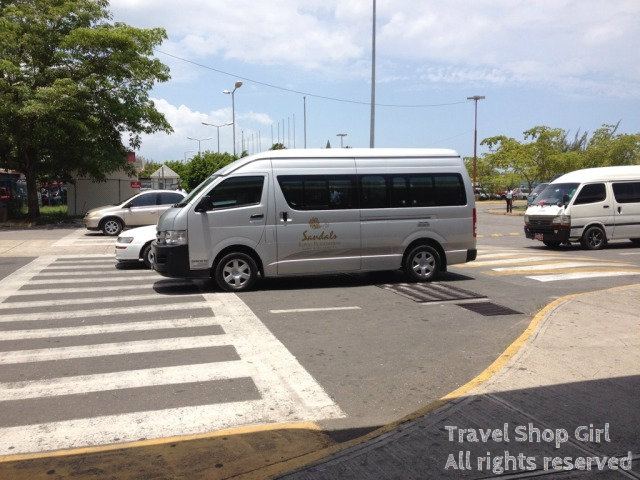
On my first day in Jamaica, I stayed at the Holiday Inn Sunspree resort, which was only a few minutes from the airport. We rode back to the airport and caught the Sandal’s shuttle to Sandals Whitehouse, where we would be staying from May 17th-May 20th. Since we weren’t flying out, we weren’t allowed to re-enter the airport. Instead the Sandals & Beaches representative took our names, tagged our luggage, and had us wait for the shuttle outside. Depending on when you travel, you might ride in a Sandals-branded shuttle or simply a shuttle van hired by Sandals to take you to their resort. Taxis are governed by JUTA (Jamaica Union of Travelers Association), which is why it is best to arrange all transport within the airport terminal at the taxi dispatch center. If you are traveling to Sandals, your transfers are included in the package price of your trip. All you need to do is board the shuttle to your final destination and you don’t need to worry about spending any money for the trip.
If you’re staying in Montego Bay, your resort might be a 5, 10, or 15-minute trip from the airport. If you’re staying in Ocho Rios, you can expect a 90-minute trip to the resort from the airport, but at least you’ll be driving on the north coast highway, which has been substantially improved and has cut the travel time down significantly. If you’re going to a resort in Negril, it could be as much as a 2-hour drive. But if you are driving to Whitehouse, like we did, you can expect a 90-minute drive on one of the most narrow, windy, bumpy roads you have ever seen. There wasn’t a single person on our shuttle who didn’t complain about not feeling queasy, whether they were prone to getting car sick in the past or not. It was a brutal ride and although the ultimate destination was amazing, the car ride was just awful. My suggestion is to sit facing forward and unfortunately, by doing so you’ll miss the view, but at least you won’t get car sick. I was trying to work on my laptop on the way down and that was a huge mistake. Alternatively, you can always hire a helicopter (from somewhere similar to this helicopter hire) to take you there and the ride will be shorter and less painful although priced at about $600-$700 for the twenty minute ride one way for up to four people. I absolutely would pay for it to avoid the car ride to and from the resort.
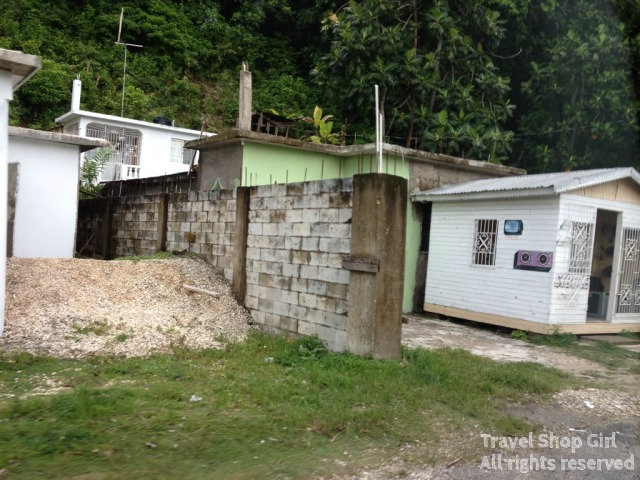
Along the way, one can’t help but notice the variety of homes that people live in on Jamaica. Some are quite small and look to be no more than a one room in size, but many others have rebar sticking out of them, as if they are in the process of construction. Apparently, this is because most Jamaicans will buy the size home they can afford and then will add on rooms over time. Instead of buying a home that’s more than they can afford or buying a small home and moving up into a larger home, they simply add onto their homes. Maybe that sounds strange, but when you think about it, it is quite logical. Instead of living above your means in a home that you can’t afford or having to move every couple of years, you live in what you suits you financially.
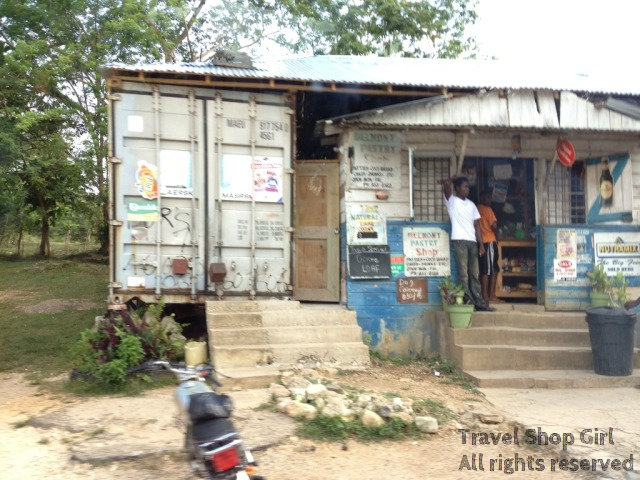
On more than one occasion I saw storage containers, the kind you might see at a freight port, used as a store or a house in Jamaica. Once again, the ingenuity of the Jamaican people is amazing and I can’t say that I’ve seen this anywhere else. I saw a P&O container with two “windows” cut out and they installed windows and put up curtains. To them it was home and wasn’t anything unusual I’m sure, but it kind of catches you off guard when you see it. After all, the average person in Jamaica earns about $50 USD per week and the unemployment rate in 2010 was 12.4%. With a population of just under 3 million, this largely Catholic country has not mistaken the importance that tourism has on its economy and embraces the more than 1.3 million tourists that visit each year. In addition to tourism, Jamaica is the fifth largest exporter of bauxite in the world, after Australia, China, Brazil and Guinea. Bauxite is used to make aluminum and although it cannot be made in Jamaica, it is mined there.
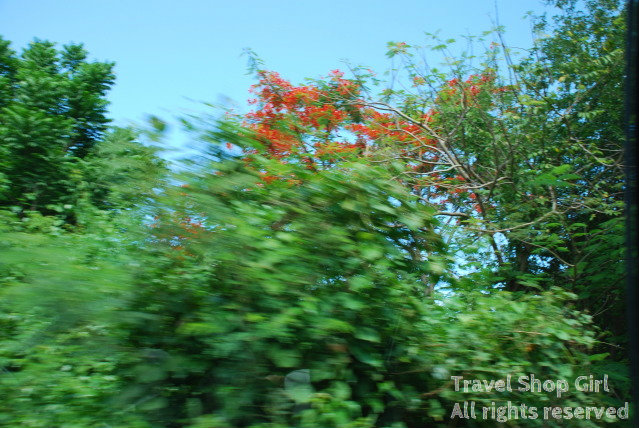
The national fruit of Jamaica is ackee. Never heard of it? Don’t worry about it because I’m sure most people haven’t. I took this picture in a moving vehicle and I’m hoping (really I am!) that this is the ackee tree about which I heard so much. The fruit was imported to Jamaica from West Africa (probably on a slave ship) before 1778. From About.com:
Ackee is considered a fruit but it is cooked and used as a vegetable. It forms one half of Jamaica’s national dish of Ackee and Salt Fish.
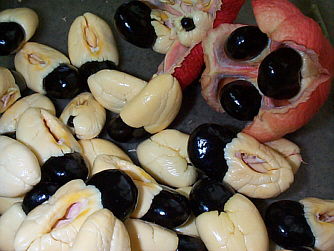
Grown and available throughout the year, more abundantly in Jamaica, the fruit is considered to be fully developed, matured, ripe and suitable for consumption when the pods become a bright red and split open to expose the edible fruit. The pod opens to expose three or four cream colored sections of flesh topped with glossy black seeds.
People outside of the Caribbean who may not be familiar with Ackee often remark that it looks like scrambled eggs and indeed it does but it’s taste if far from that of scrambled eggs. Ackee is creamy in texture, delicate like eggs but has a finishing taste that is slightly bitter. It is subtle and only detected by a discerning palate.
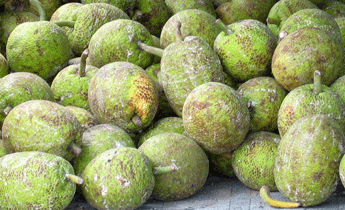
Ackee not your thing? What about breadfruit? From the GetJamaica.com website:
Jamaican breadfruit is one of the oldest and most versatile Jamaican food used in a wide range of Jamaican food recipes. Jamaican breadfruit can be boiled, roasted and even fried and can be served as a great Jamaican side dish as well as a main course with other Jamaican vegetables, such as Jamaican ackee recipe with fried or roasted breadfruit.

Another interesting food in Jamaica that I found was cho cho. This tropical fruit that is native to Mexico and Central America, it is probably better known as chayote. Ask someone who speaks Spanish if they have heard of cho cho and you might not get the response you were looking for with this question! From the BestJamaica.com website:
The Jamaican cho cho is used in many as a vegetable to fruit. Although this fruit has a bland taste it is eating raw in salads and salsa or with lemon juice. In its cook form it is tasted like a cross between potato and cucumber.
I had cho cho boiled and it did definitely taste more like a root vegetable than a fruit. As someone who enjoys boiled plantains, eating plantains and cho cho for breakfast was quite enjoyable and I appreciated it more than any bowl of cereal that could be served to me.
What does driving around Jamaica, ackee, breadfruit, and cho cho all have in common? They all require that you take a chance and be open to the idea of trying new things. You may think you won’t like ackee, but if you haven’t tried it, how would you know? You may like Montego Bay, but are afraid of the long car ride to Negril or Ocho Rios, but if you don’t take a chance and try it, how will you ever know what the rest of the island is like? Don’t be so quick to shoot down the opportunity to learn more about the world you live in even if it seems strange or scary to you. The more often you try something and step out of your comfort zone, you’ll find that there are fewer and fewer things in this world that are truly scary or unusual.
What things have you tried while traveling that were really different or scary that you are glad you had the chance to try?




Great Blog and not many visitors get to see the real Jamaica. visit http://www.courtneytaylortours.com for some real Jamaican Tours
“They all require that you take a chance and be open to the idea of trying new things.” I looooove that you said this! Life should be all about curiosity.
Thanks Andi! If you aren’t curious, are you truly living life? I don’t want to be a passive observer full of regret, you know?